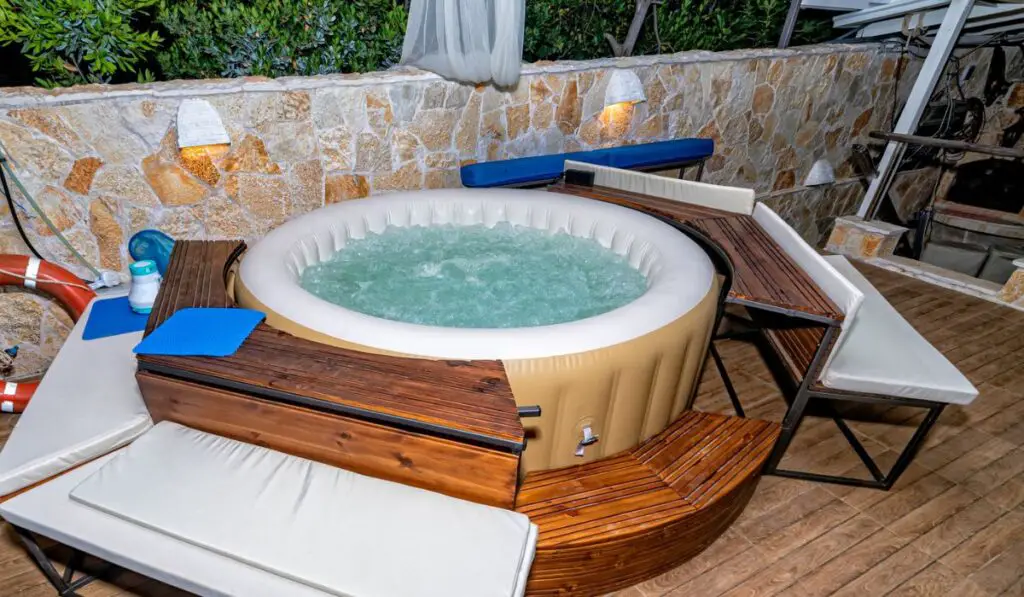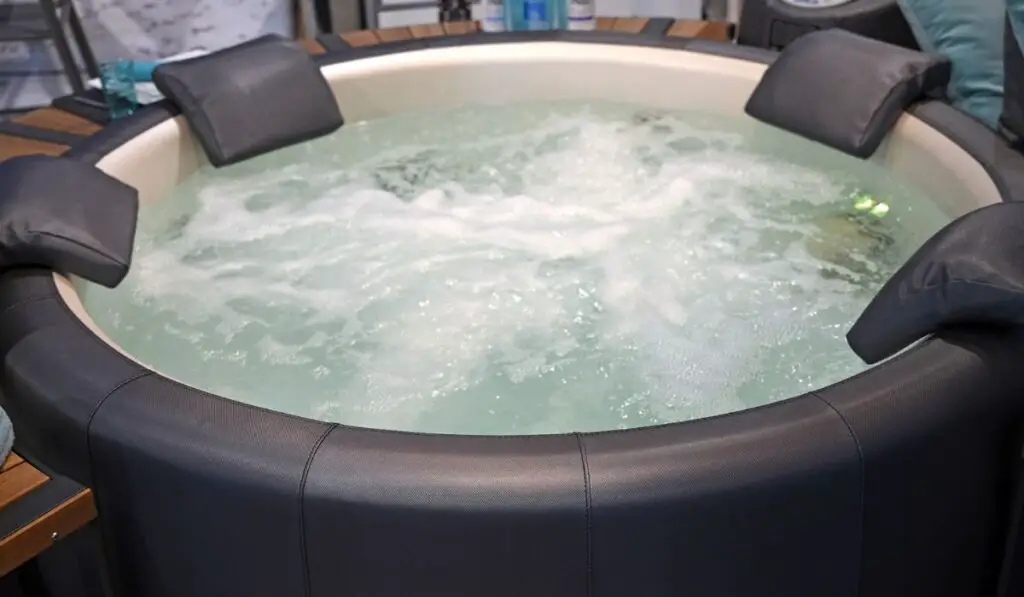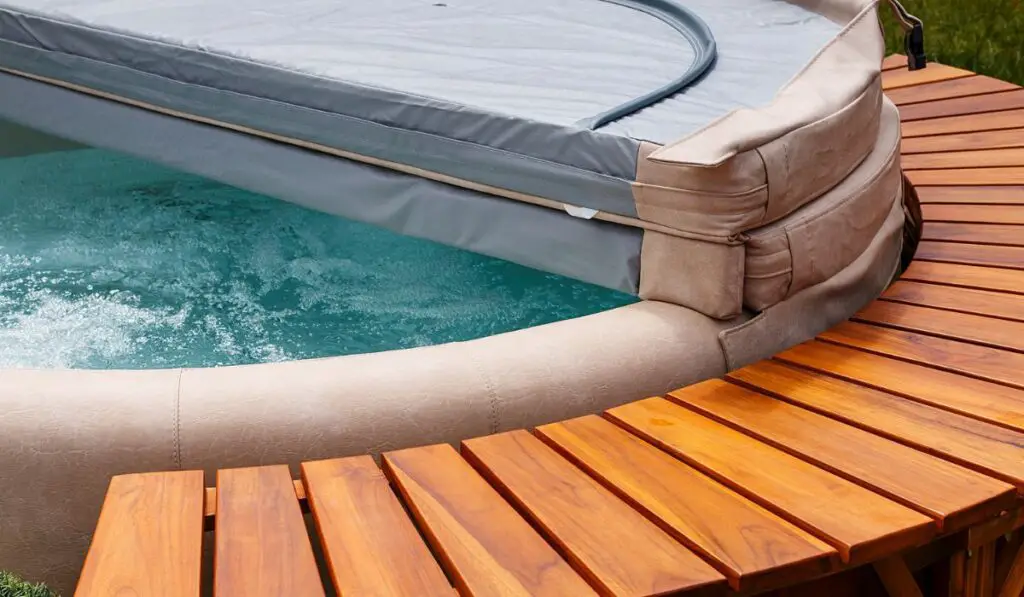Inflatable hot tubs have become increasingly popular in recent years. But, while they are designed to keep you relaxed in the winter, extreme cold temperatures can damage the tub. So, how do you protect your tub from winter damage?
The best way to protect your hot tub in the winter is to insulate it. Covering the tub, keeping the water running, and draining the water can also be effective. Installing an additional heater may help prevent freezing.
Let’s explore ways to protect your hot tub from winter damage, how to use it when the temperature drops below freezing, and general maintenance tips to prolong your hot tub’s lifespan.
Are Inflatable Hot Tubs Safe to Be Left Outside During the Winter?

It’s not usually safe to leave your inflatable hot tub outside during the winter, especially in freezing temperatures. You still can use your hot tub in the winter, but you’ll have to take special care that it doesn’t get damaged.
The water will freeze if you leave the tub outside in the cold. It will then require more energy to get hot again, increasing your energy bill.
Inflatable hot tubs usually don’t have a pump and a blower. So, if its jets are frequently used, it will be harder to maintain the hot water. Also, keeping the hot tub outside in the winter will worsen as it can freeze the jets. If the jets get frozen, the stagnant water will be more at risk of freezing.
Also, an inflatable hot tub has vinyl walls, and cold weather can damage these walls.
Whether you should leave the inflatable hot tub outside in the winter also depends upon other factors, like the climate you live in and the size and dimensions of your tub. For example, if you have a small hot tub, you can quickly drain and deflate it and then store it indoors instead of keeping it outside.
But if the size is too large, the tub needs to be correctly drained, cleaned, and stored when it’s not in use.
What’s the Lowest Temperature an Inflatable Hot Tub Can Withstand?
Professionals recommend keeping the tub outside if the temperature is above 40 degrees Fahrenheit. Inflatable hot tubs can withstand upper temperatures of up to 104 degrees Fahrenheit.
Therefore, you can safely use your hot tub outdoors when the temperature is within this range.
Extreme temperatures can cause severe damage to the tub. However, you can still use a hot tub out of the ideal temperature range, but this depends upon the model of your tub.Some models have powerful heaters; some are better insulated and can be used even in low temperatures.
While you may want to use the hot tub in the winter, if the temperature is at or below freezing, it’s better not to keep it outside.
How to Protect Your Hot Tub from Damage During the Winter

To protect your tub from winter damage, insulate the tub bottom, adequately cover the tub, hook up the heater, keep the tub running and drain it properly when not in use. You’ll also prolong its lifespan by keeping pets away.
If you haven’t maintained your hot tub in a while, you’ll need to take a few additional measures to protect it, such as cutting the power, removing the filters, and cleaning the plugs. But if you find it too damaged, shut it down in the winter and call a professional for maintenance.
Ways to protect your hot tub from damage in the winter include:
Insulate the Bottom of Your Tub
When you want to enjoy a spa in the winter, it’s essential to insulate your tub correctly. Most tubs contain a heat barrier like a mat or disk, which settles between the floor and the tub’s bottom. However, this barrier might not work in cold temperatures.
Also inflated hot tubs also have vinyl walls instead of the acrylic shells that come in non-inflated wooden tubs. These have less insulation and won’t retain heat well in the winter. If you have a simple hot tub, you’ll have to insulate it if you want to use it in freezing temperatures.
As hot tubs become more popular, most modern ones are already well insulated. However, they can be expensive, and many opt for a cheaper, non-insulated option.
If you don’t buy an insulated hot tub, there’s no need to worry, as the insulation process is relatively easy. Follow these steps to insulate your inflatable hot tub:
- Buy an insulation board, preferably a foam board.
- Drain the tub thoroughly.
- Find out how much insulation the tub needs.
- Adjust the multifoil to the measurements you did.
- Screw down the side panels of the tub.
- Add the insulation carefully and re-install the side panels when it’s done.
If you don’t know how much insulation is needed, place the board on your tub and cut it to the same size and dimensions as your hot tub.
Cover Your Tub

Covering your tub when it’s not in use will protect it from winter damage. The inner part of the tub may get damaged if it’s left uncovered in the cold, and the dirt around it may stain the tub. There’s also the risk of water freezing if you leave the hot tub uncovered.
If the tub is well covered after use, it’ll retain warmth, and you won’t need to wait too long to replenish the heat when you use your tub again.
This can cost less than switching off the tub when it’s not in use and then waiting longer for the water to heat up.
Covering your hot tub will also prevent the water from getting swampy and smelly. An uncovered hot tub is more likely to have algae and bacteria build-ups, which makes the water unclean.
While you can cover your hot tub with a regular sheet, it’s not ideal as it isn’t airtight. You’ll need special fabric sheets that are thick enough to keep dirt out. If you can get a special airtight cover that also insulates the tub, it will help prolong your tub’s lifespan.
Keep Your Hot Tub Running
Keeping the water warm is essential if you are using the tub in the winter. For this, you’ll need to keep the tub running continuously. Fortunately, you’ll be able to use the hot tub even if the temperature falls below 40 degrees if you let the water circulate.
When you keep your hot tub running, the water inside remains in circulation. This is important as it will keep the water evenly heated. You’ll also use less energy over the winter if you keep the heater on.
You can also use a pump to help the water circulate and prevent freezing. Since an inflated hot tub doesn’t have a pump, you can get an additional pump to help keep the warm water in circulation. This may cost you a little bit, but it is worth making your spa moments more enjoyable.
However, you don’t need to worry if you don’t have the pump, as your tub jets can also help you keep the water running. Switch on the tub jets regularly, and they’ll help prevent the water from freezing, even in extreme temperatures.
Drain and Store Your Tub if You Won’t Be Using it
If you aren’t planning to use your hot tub in the winter, avoid keeping it outside, or you’ll risk damaging the tub. The best option is to drain the tub properly, deflate it and store it in a dry place until you plan to use it again.
If you drain the tub after use, you’ll enjoy fresh water when you take out your tub again. Also, if you always drain your tub when you are not using it, it will prevent your tub from getting algae and bacteria infestations.
Here are some guidelines to follow when you drain the water:
- Find the nozzle: Look for nozzles in your tub, as their position may vary based on your model. If you have a simple hot tub, you’ll see the nozzle at the bottom of either corner of the tub. For more complex hot tubs, visit the manufacturer’s guide if you struggle to locate the nozzle.
- Open the nozzles: Once you find the drainage nozzles, open them carefully and let the water drain out. Wait until you see the tub completely empty.
- Sock the remaining water: Check if water is still remaining in the bottom of the tub. Use a cloth to keep the tub completely dry.
- Check the filter: Checking the tub’s filter is also necessary as it may contain water which can stain the filter and give off a bad smell.
- Deflate the tub: You’ll need to deflate the tub slowly. If you deflate it incorrectly, it may damage the tub.
Protect Your Hot Tub from Pets
Keeping your pets away from the tub is ideal, especially in the winter. But if you want to enjoy the hot tub with your pets, you’ll have to be extra cautious.
While pets aren’t dangerous, their nails or teeth can puncture an inflatable tub. In addition, inflatable hot tubs have vinyl walls instead of wooden walls, which are more likely to get damaged by the sharp nails and teeth of pets.
Also, unless you keep your pet inside, you’ll need to bathe them before taking them near the hot tub.
In any case, it’s never a good idea to take your pets to a warm spa or hot tub when the weather is cold, as they are more likely to get ill from temperature fluctuations.
Get an Additional Heating Element
If you plan on using your hot tub in cold weather, you can get an additional heating element to prevent the water from freezing. However, since most inflatable hot tubs don’t have pumps attached, it places more strain on the single heating element when the temperature is below freezing.
While the best option is to shift your hot tub inside in the winter, getting an additional heating element will also allow you to use it outdoors. It will also reduce the strain on the existing heating element and prolong your hot tub’s lifespan.
